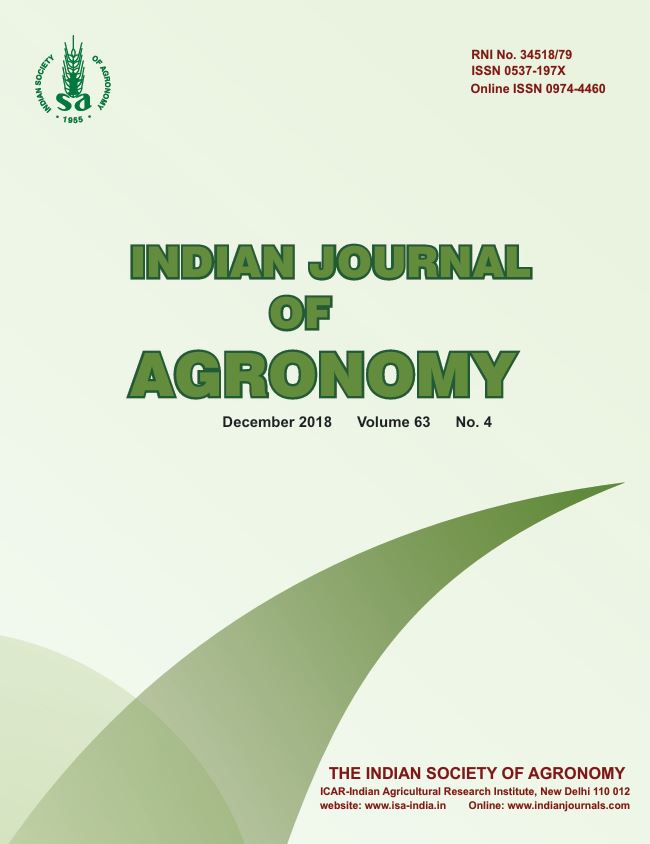Effect of moisture conservation techniques on productivity, water-use efficiency and economics of Bt cotton (Gossypium hirsutum) in southern Rajasthan
DOI:
https://doi.org/10.59797/ija.v63i4.5685Keywords:
Bt. cotton, Drip irrigation, Economics, Polymulching, Water-use efficiency, YieldAbstract
A field experiment was conducted during 2 consecutive kharif seasons of 2014 and 2015 at Banswara, Rajasthan to assess the effect of moisture conservation techniques like, polymulching and drip irrigation on productivity, water-use efficiency and economics of Bt. cotton (Gossypium hirsutum L.) in sourthern Rajasthan. The experiment was laid out in randomized block design with 3 replications comprising eight treatment combinations. The results revealed that polymulching improved the growth, yield, nutrient uptake and water-use efficiency compared to conventional irrigation. Polymulching increased seed-cotton yield and water-use efficiency by 42.5 and 99% respectively in comparison to conventional irrigation. Drip irrigation with polymulching was significantly superior to drip irrigation without polymulching at all irrigation regimes. Water-use efficiency was observed the highest (93.6 kg/ha-cm) under drip irrigation at 0.6 ETc + polymulching, while the lowest (28 kg/ha-cm) was recorded under conventional irrigation. The uptake of NPK was significantly influenced by polymulching and drip irrigation (with and without polymulching) compared to conventional irrigation. The maximum seed cotton yield (5,504 kg/ ha), gross returns ( 220,145/ha) and net returns ( 169,105/ha) were recorded under drip irrigation at 0.8 ETc + polymulching, which was at par with drip irrigation at 0.6 ETc + polymulching and significantly superior to rest of the treatments. Maximum B: C ratio (3.31) was also recorded under drip irrigation 0.8 ETc + polymulching, which remained at par with drip irrigation at 0.6 ETc + polymulching, drip at 0.8 ETc without mulching and polymulching in conventional irrigation. Drip irrigation at 0.6 ETc with polymulching can be recommended as best moisture conservation technology for enhancing productivity of Bt. cotton under the agro-climatic condition of southern Rajasthan.
References
Brouwer, C. and Heibloem, M. 1986. Irrigation water needs. Irrigation Water Management and Training Manual No. 3. FAO, Rome, Italy.
Cetin, O. and Bilgen, L. 2002. Effects of irrigation methods on scheduling and yield of cotton. Agricultural Water Management 54: 1–15.
Chen, D., Ye., G., Yang, C., Chen, Y. and Wu, Y. 2005. Effect of introducing Bacillus thuringiensis gene on nitrogen metabolism. Field Crops Research 92(1): 1–9.
Choudhary, K.K., Dahiya, R. and Phogat, V.K. 2016. Effect of drip and furrow irrigation methods on yield and water-use efficiency in cotton. Research on Crops 17(4): 823–828.
Cotton Advisory Board. 2016. Minutes of the Cotton Advisory Board. Textile Commissioner of India, Ministry of Textile, Govt. of India, Mumbai.
Hargilas and Saini, D.P. 2017. Response of precision application of water and fertilizer on productivity and economics of Bt cotton. Journal of Plant Development Sciences 9(5): 471–475.
Hargilas and Saini, D.P. 2018. Influence of mulching and irrigation regimes under drip irrigation on productivity and profitability of Bt cotton and resources use efficiency. Abstract of International Conference on Cotton and Other Fibre Crops. ICAR-Research Complex for NEH Regional Station, Umiam, February 15–16, 2018. pp. 124–125.
Nalayini, P., Paul Raj, S. and Sankaranarayanan, K. 2011. Growth and yield performance of cotton (Gossypium hirsutum) expressing Bacillus thuringiensis var. Kurstaki as influenced by polyethylene mulching and planting techniques. Indian Journal of Agricultural Sciences 81(1): 55–59.
Nalayini, P., Paul Raj, S. and Sankaranarayanan, K. 2013. Water-use efficiency, nutrient uptake and production potential of extra long stable Bt cotton-maize system with moisture conservation techniques and ET based irrigation. Journal of Cotton Research and Development 27(1): 45–49.
Nalayini, P., Raja, R. and Anderson, A.K. 2006. Evapo-transpiration based scheduling of irrigation through drip for cotton (Gossypium hirsutum). Indian Journal of Agronomy 51(3): 232–235.
Prajapati, G.V. and Subbaiah, R. 2015. Response of Bt cotton productivity to conjunctive stimulus of irrigation regimes and mulching. Research on Crops 15(3): 509–514.
Ramamurthy,V., Patil, N.G., Venugopalan, M.V. and Challa, O. 2009. Effect of drip irrigation on productivity and water-use efficiency of hybrid cotton (Gossypium hirsutum) in Typic Haplusterts. Indian Journal of Agricultural Sciences 79(2): 118–121.
Rane, N.B. 2011. Development, scope and future potential of fertigation in India. (In) Proceedings of National Seminar on Advances in Micro-irrigation. February 15–16, 2011. NCPAH, Ministry of Agriculture, GoI. pp. 44–54.
Yang, Xiangkun, Zhang, Zhanqin, Niu, Yuan, Tian, Haiyan and Ma, Fuyu. 2017. Cotton root morphology and dry-matter accumulation at different film removal times. Agronomy Journal 109(6): 2,586–2,597.






